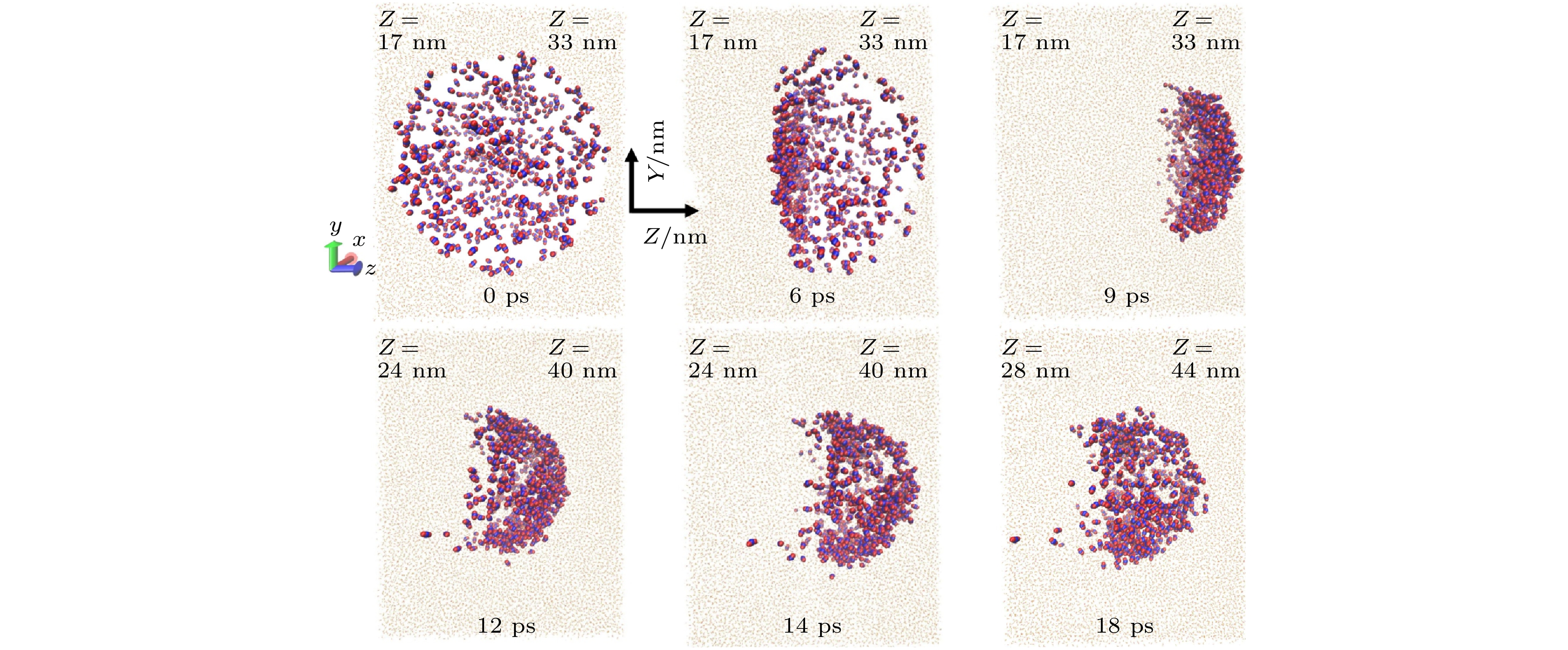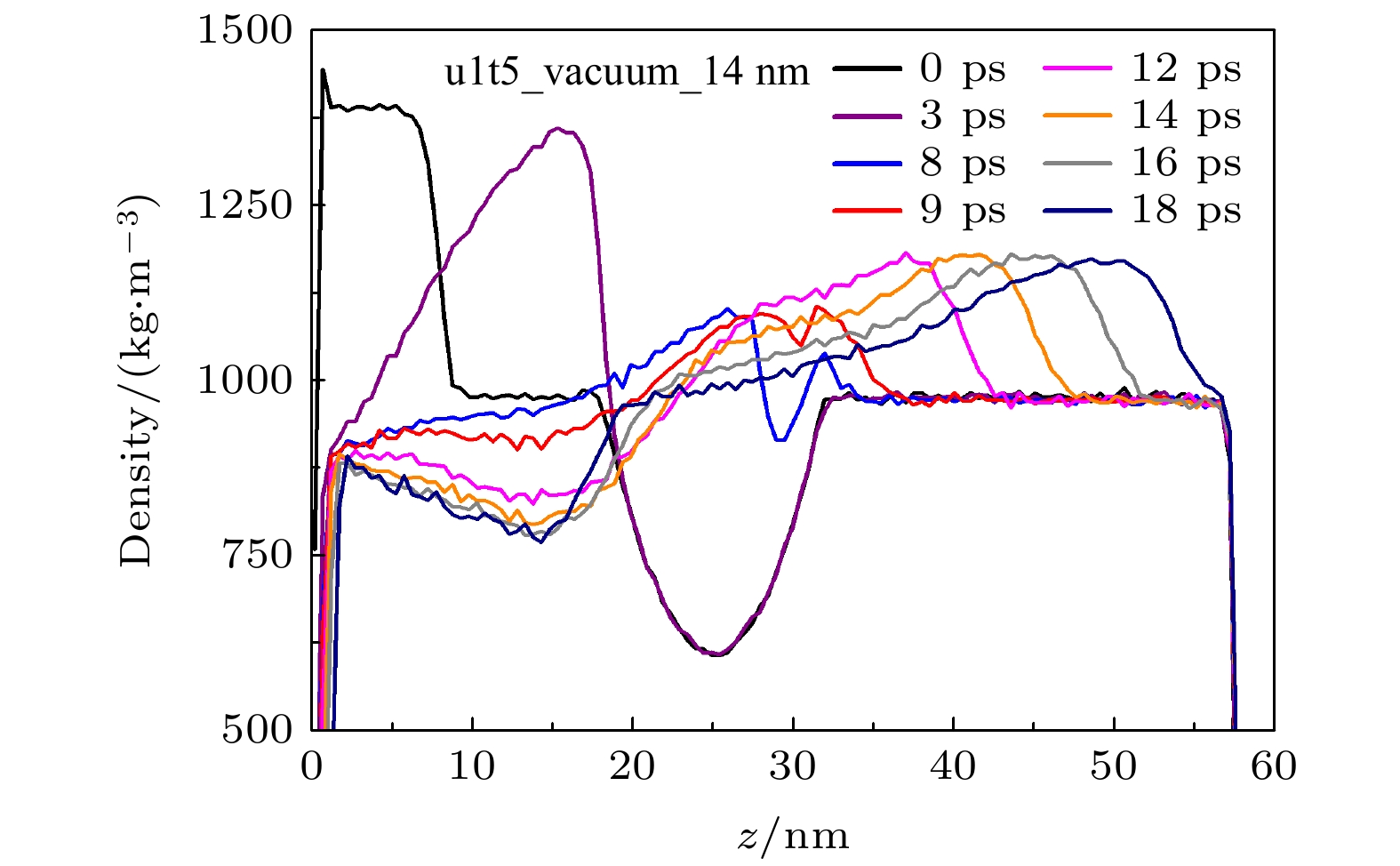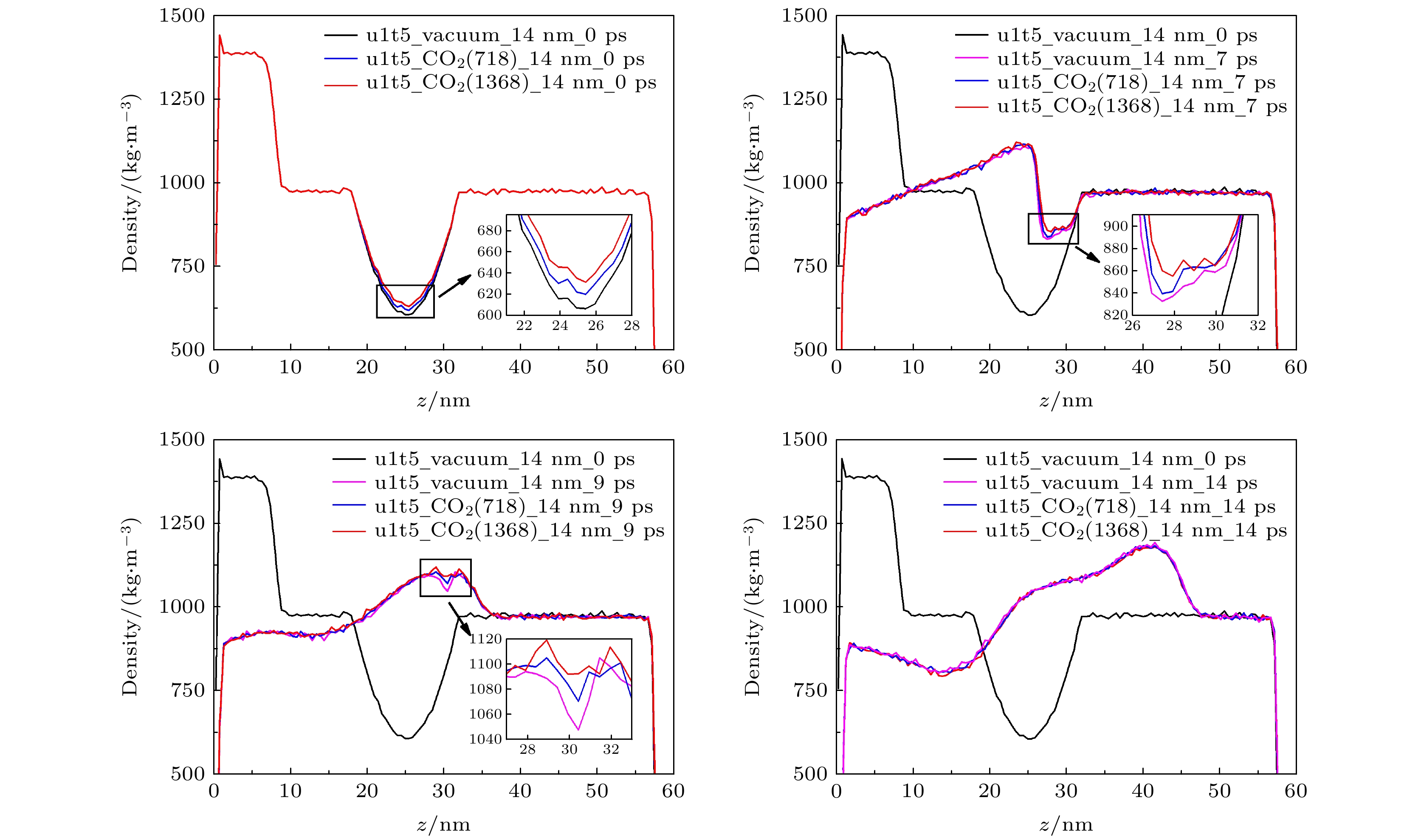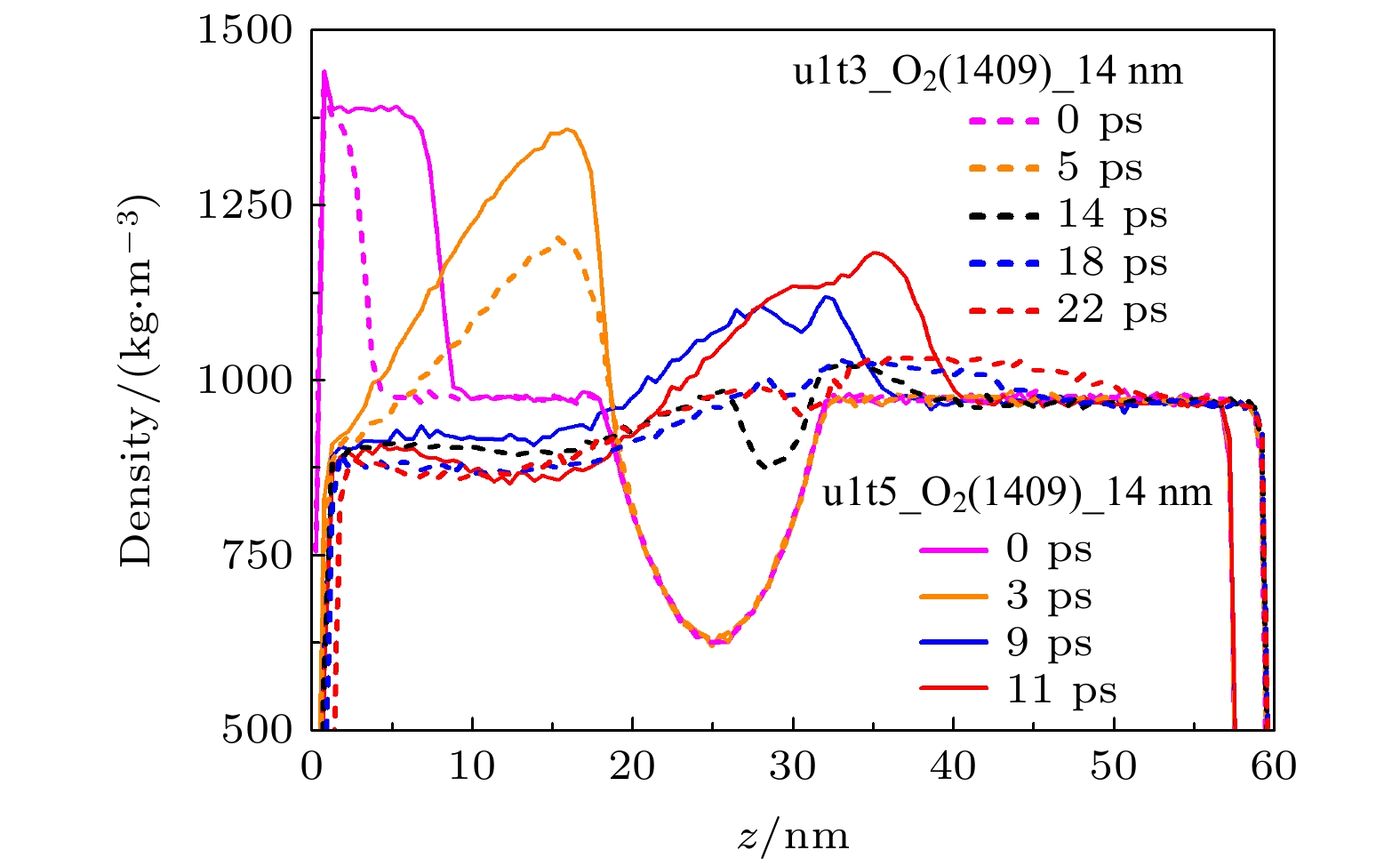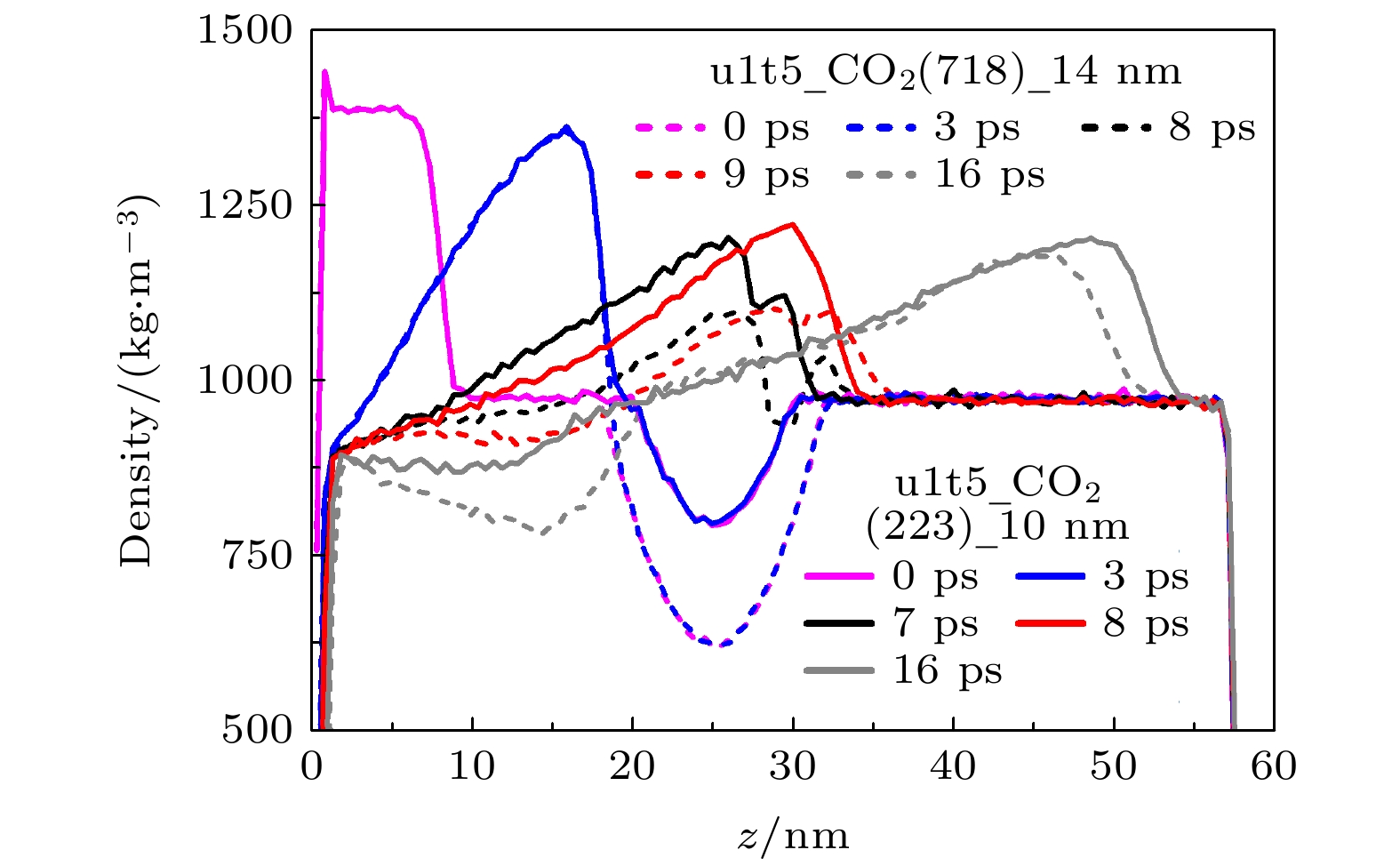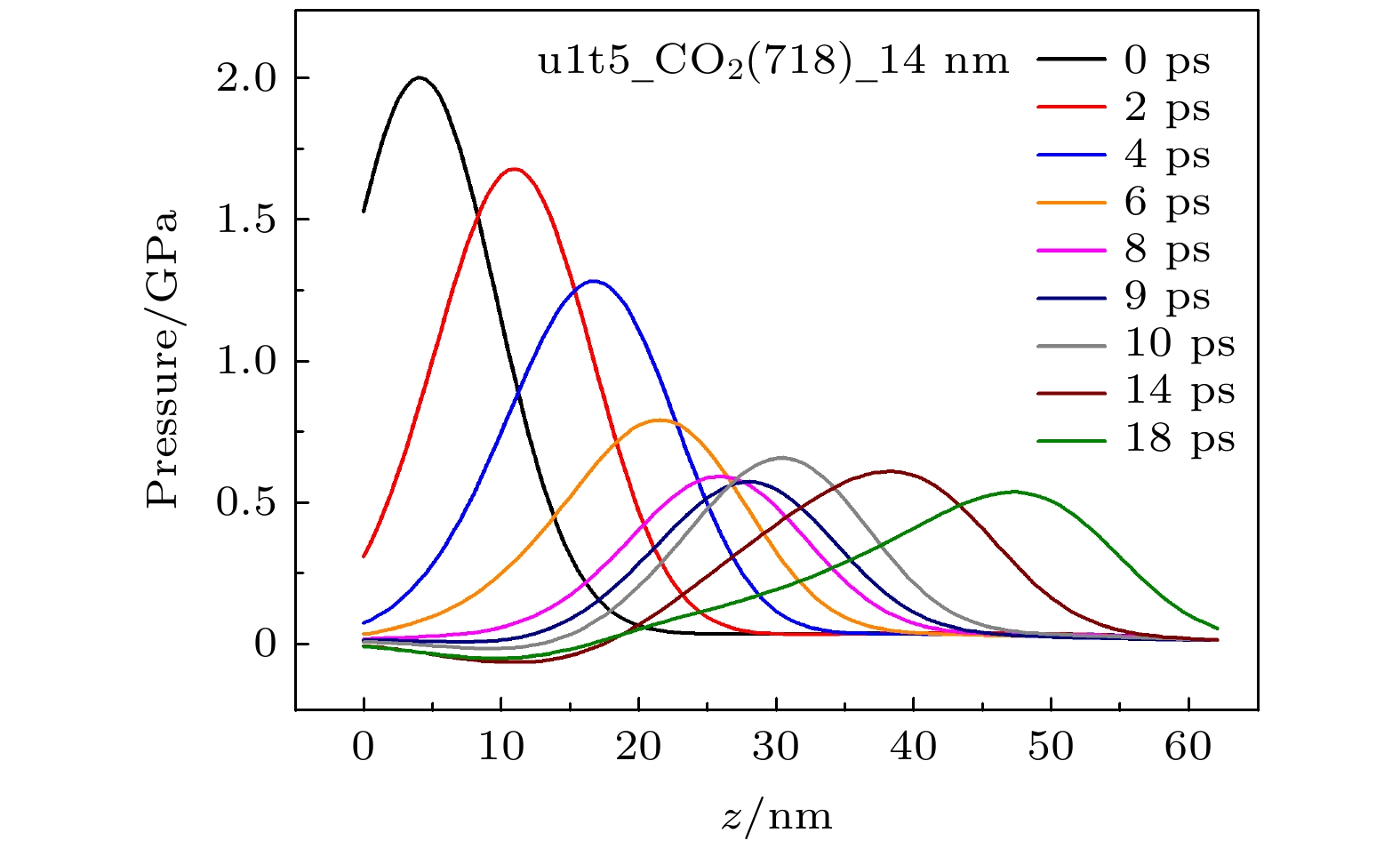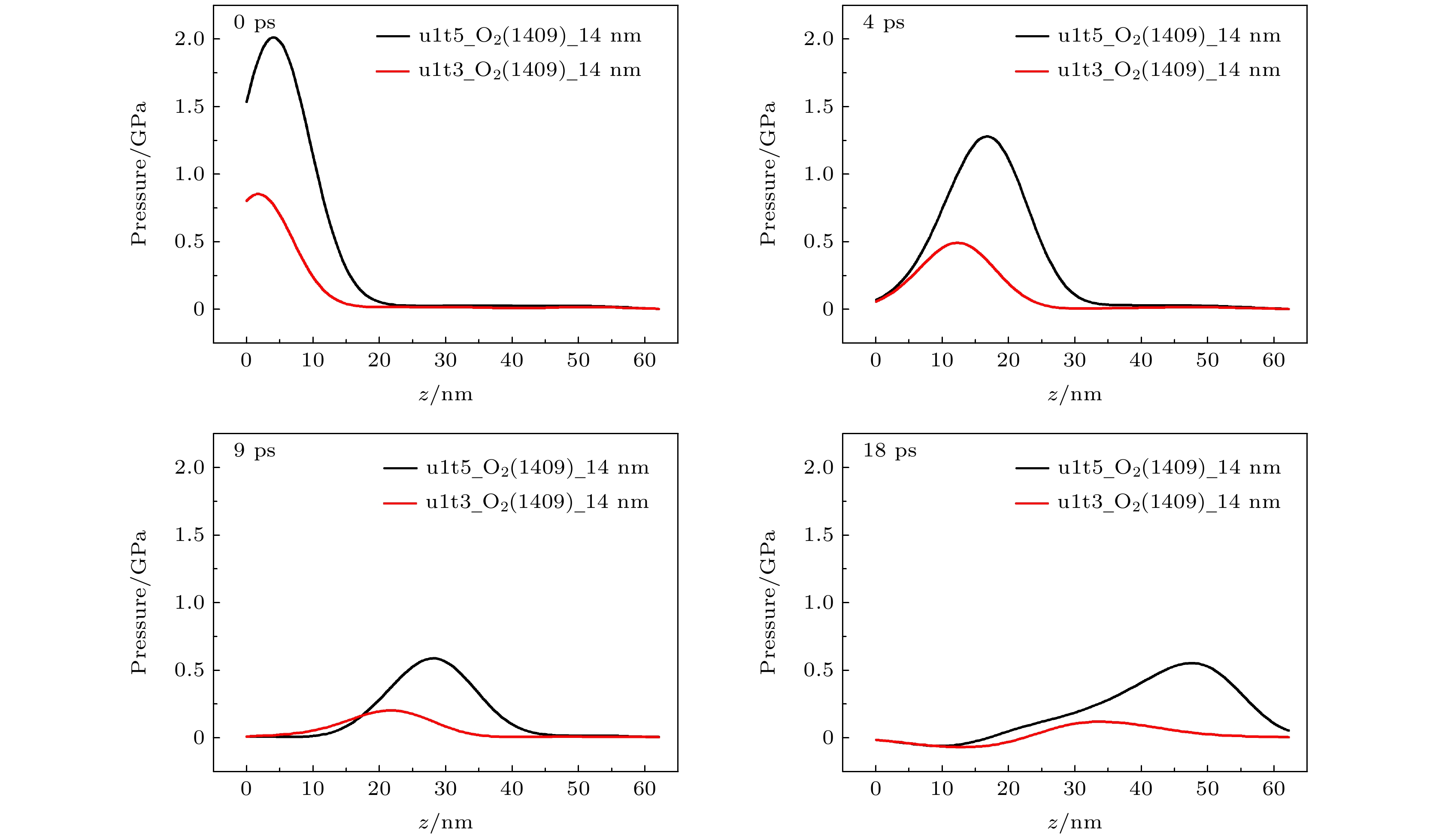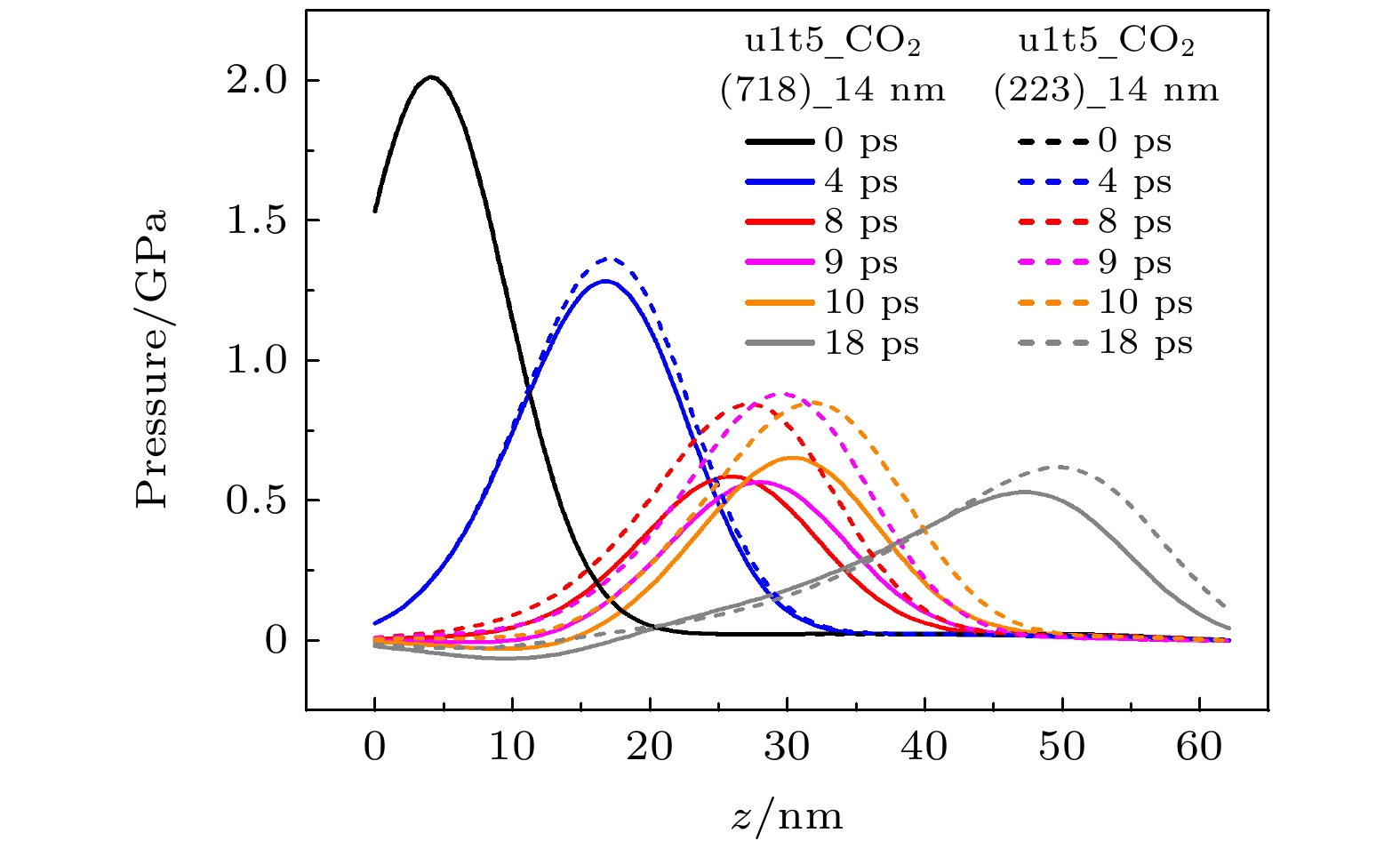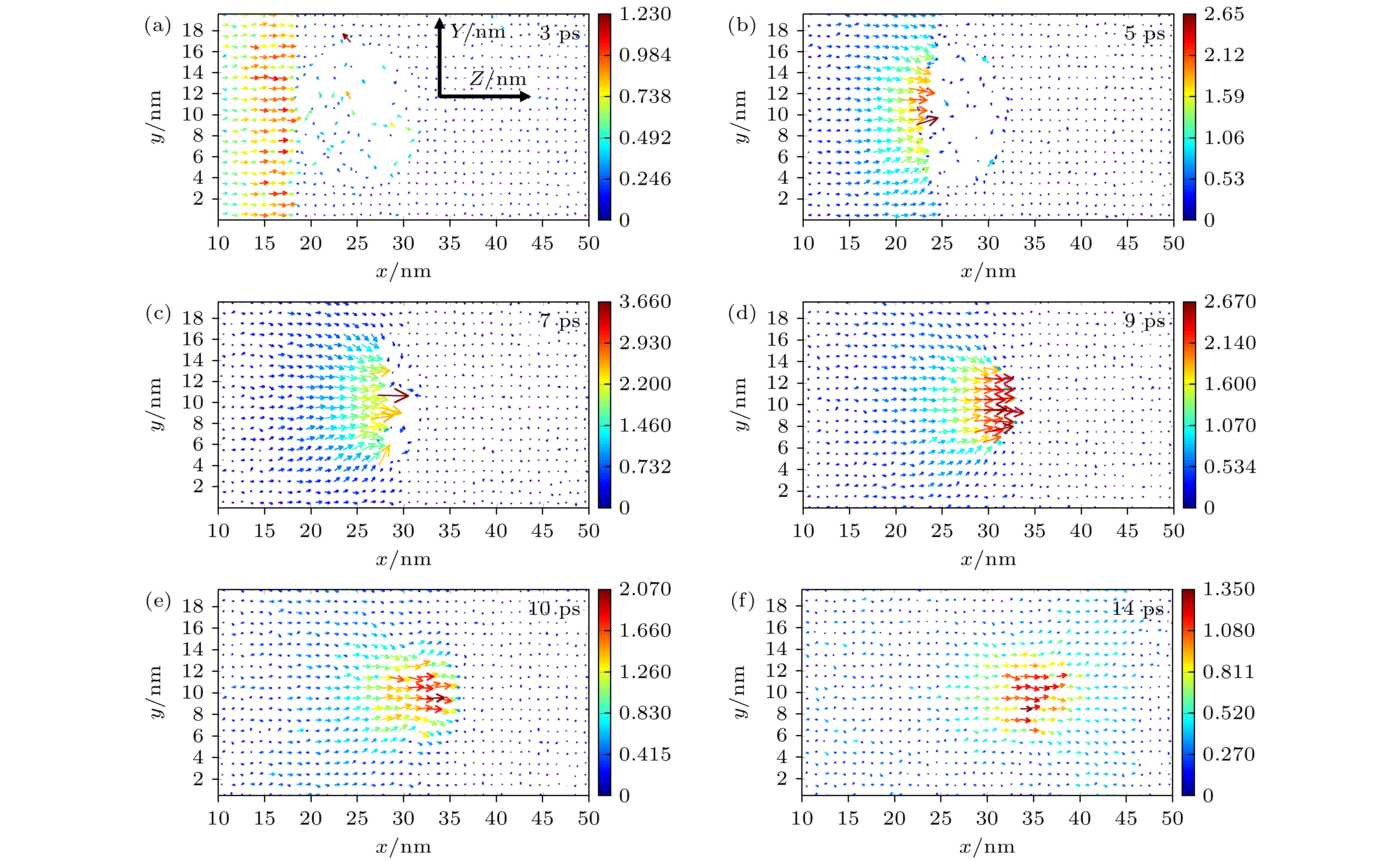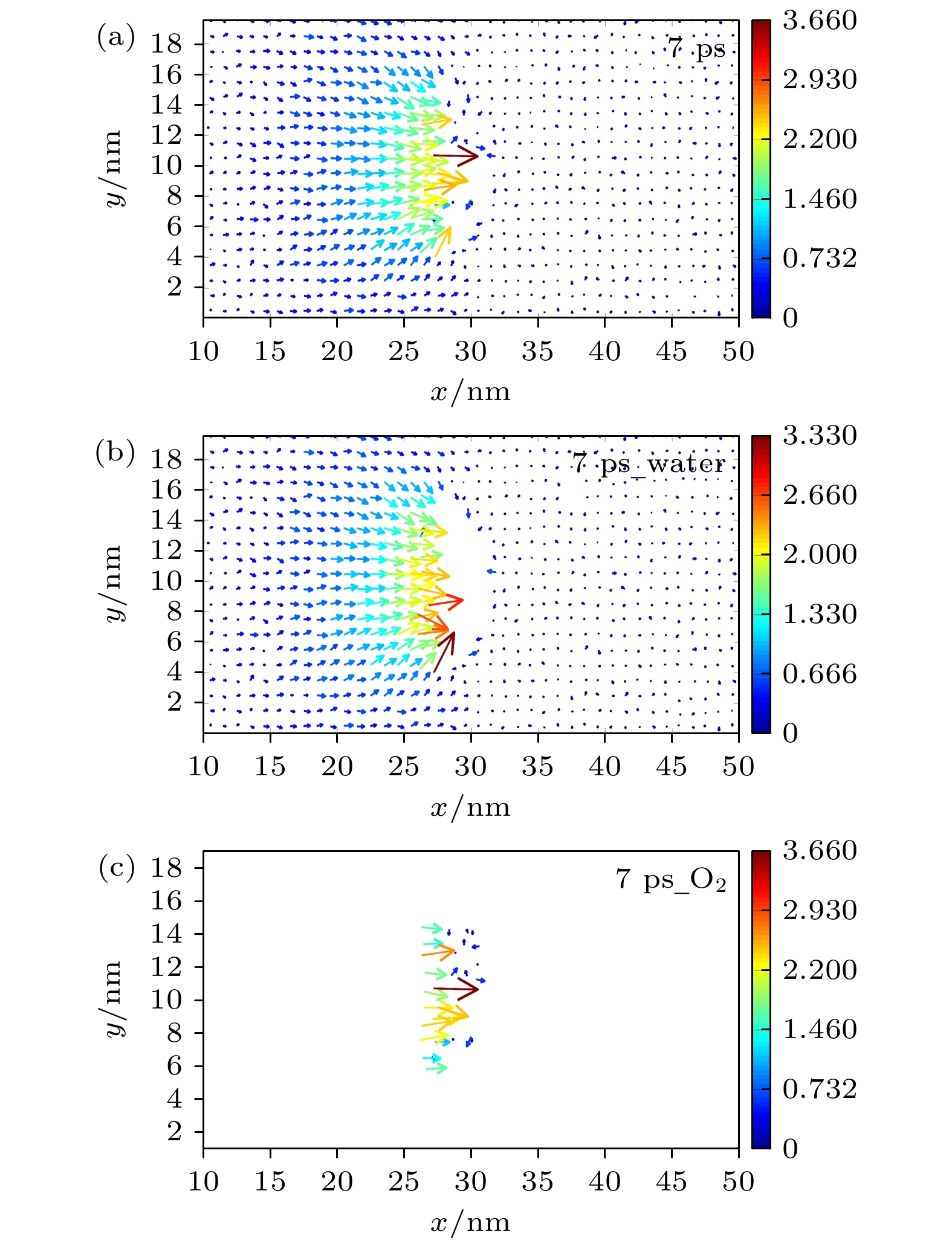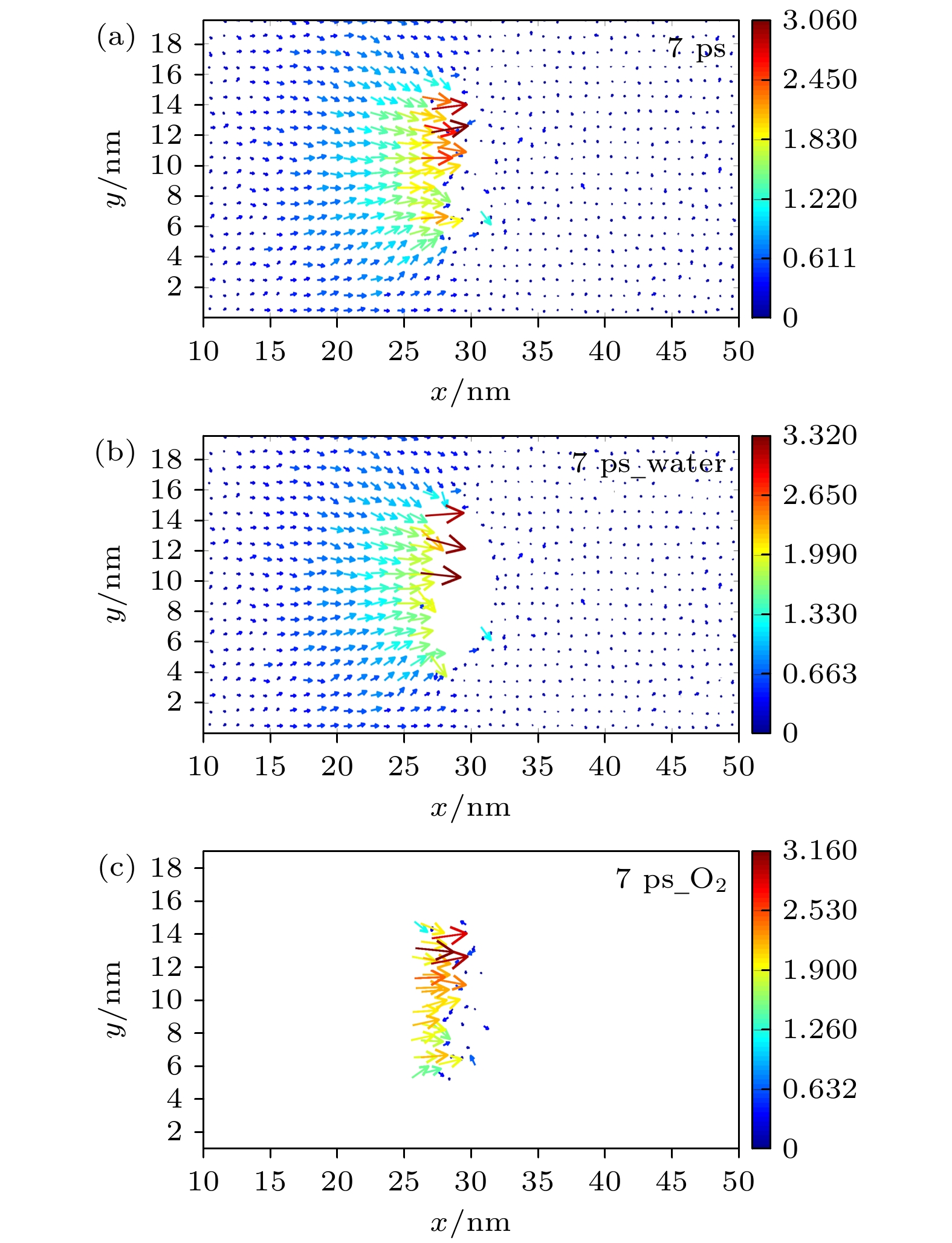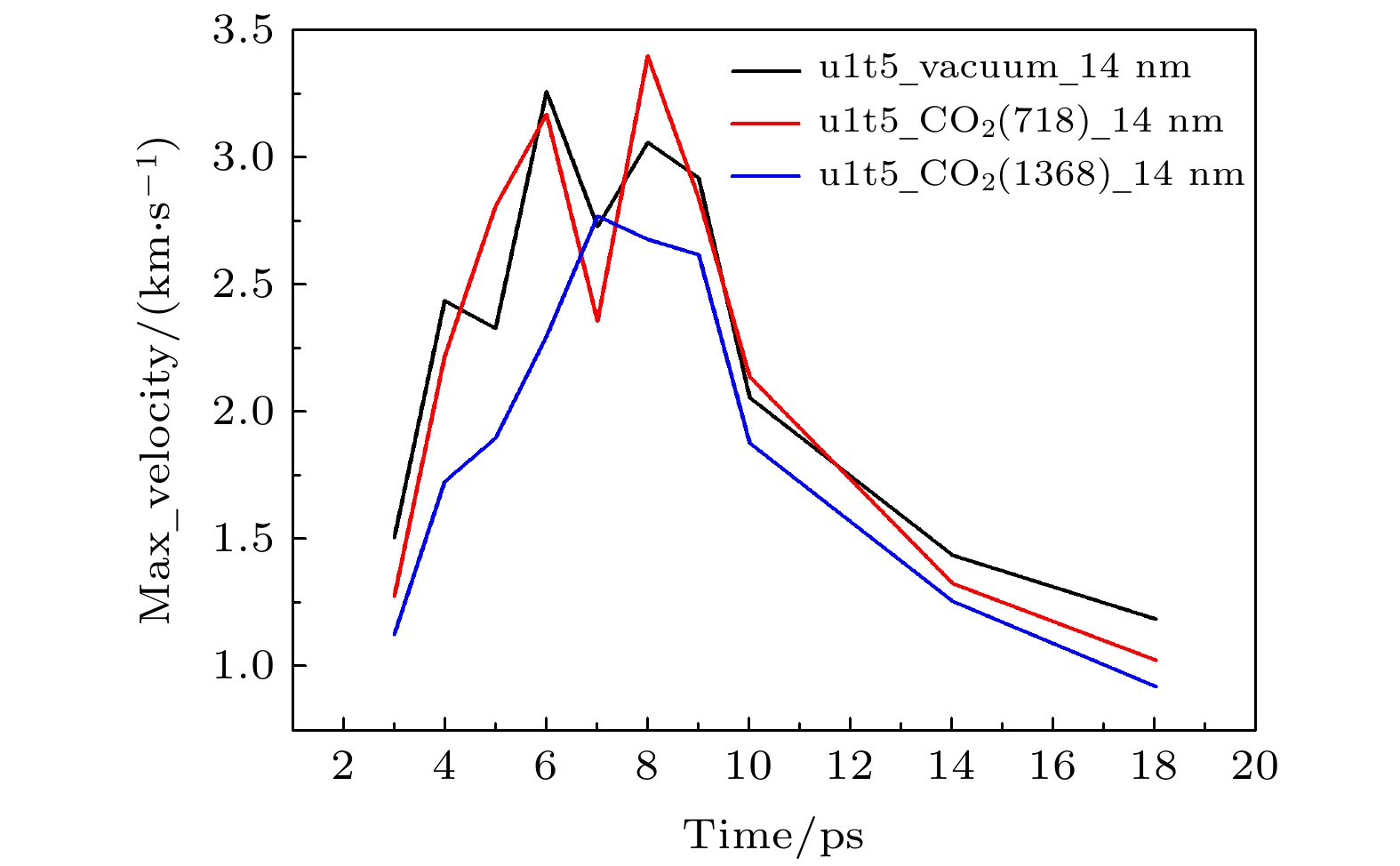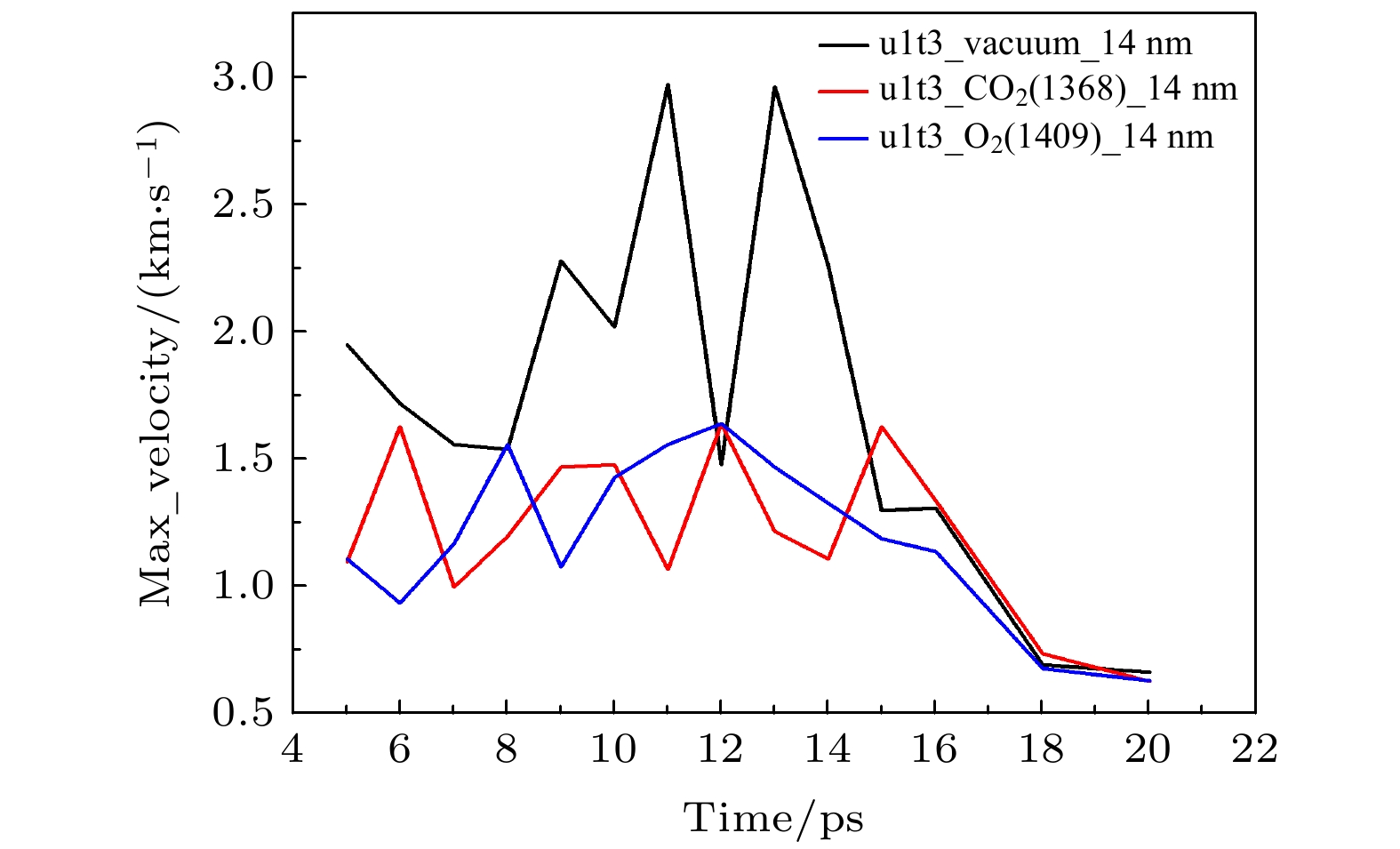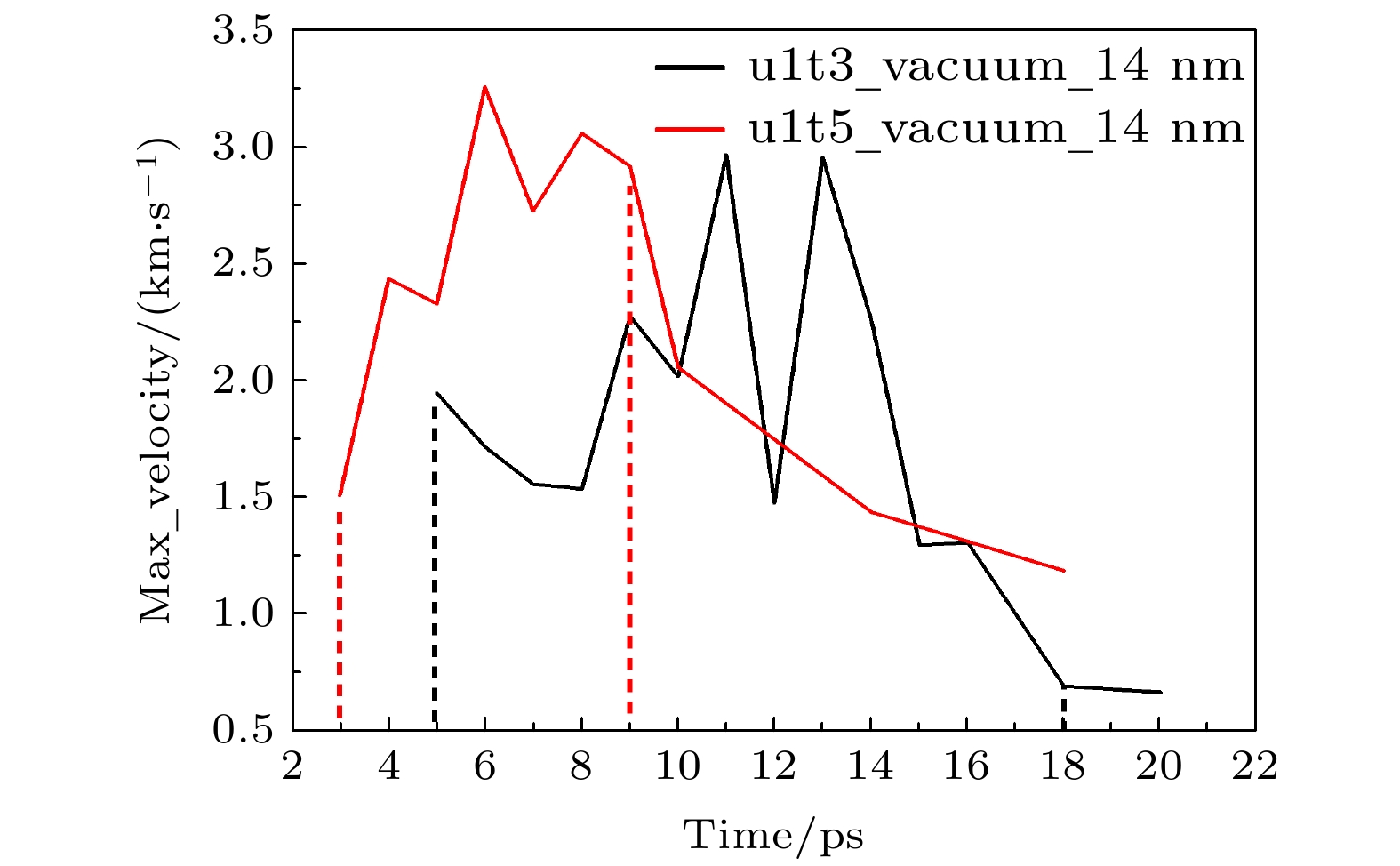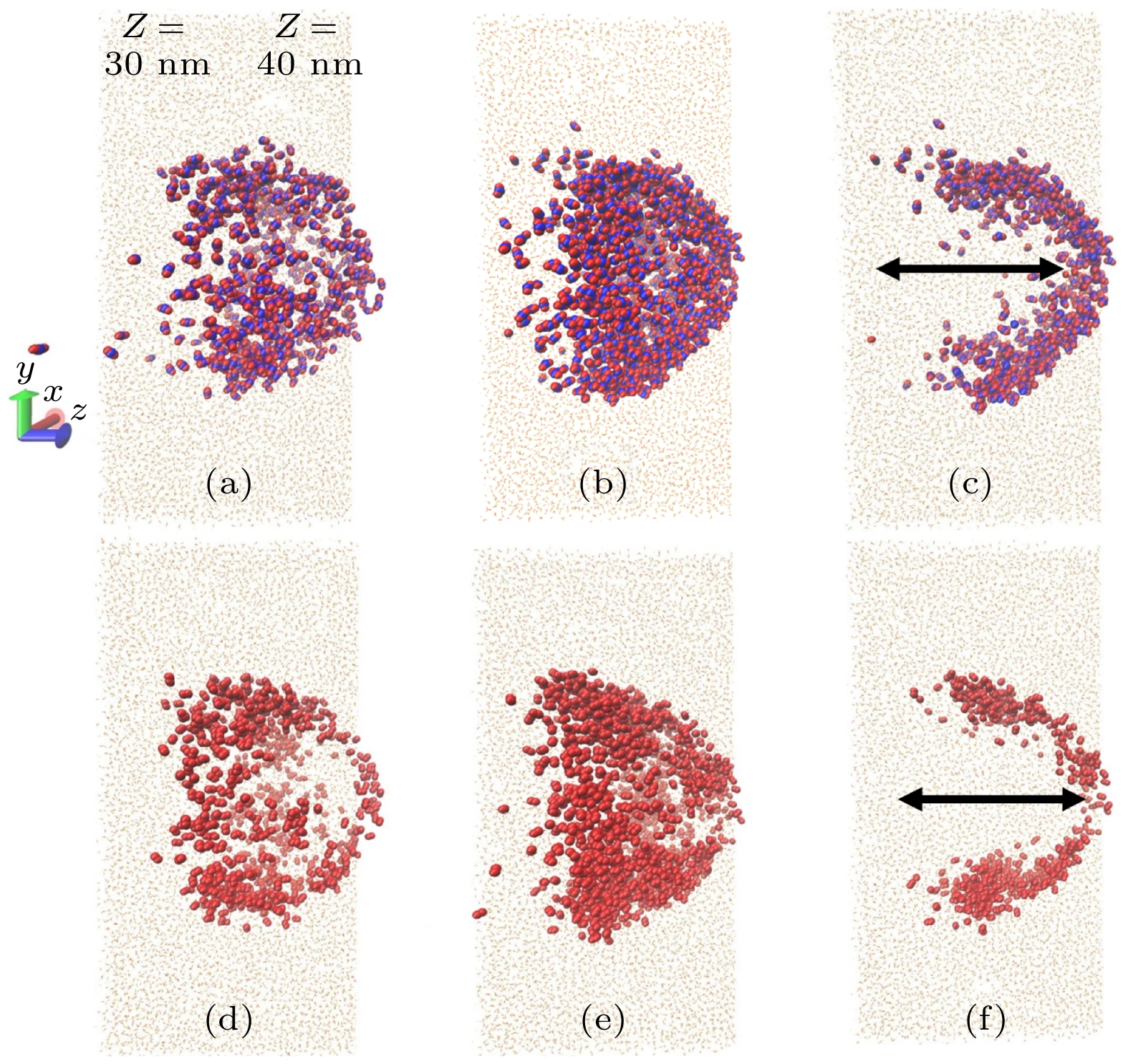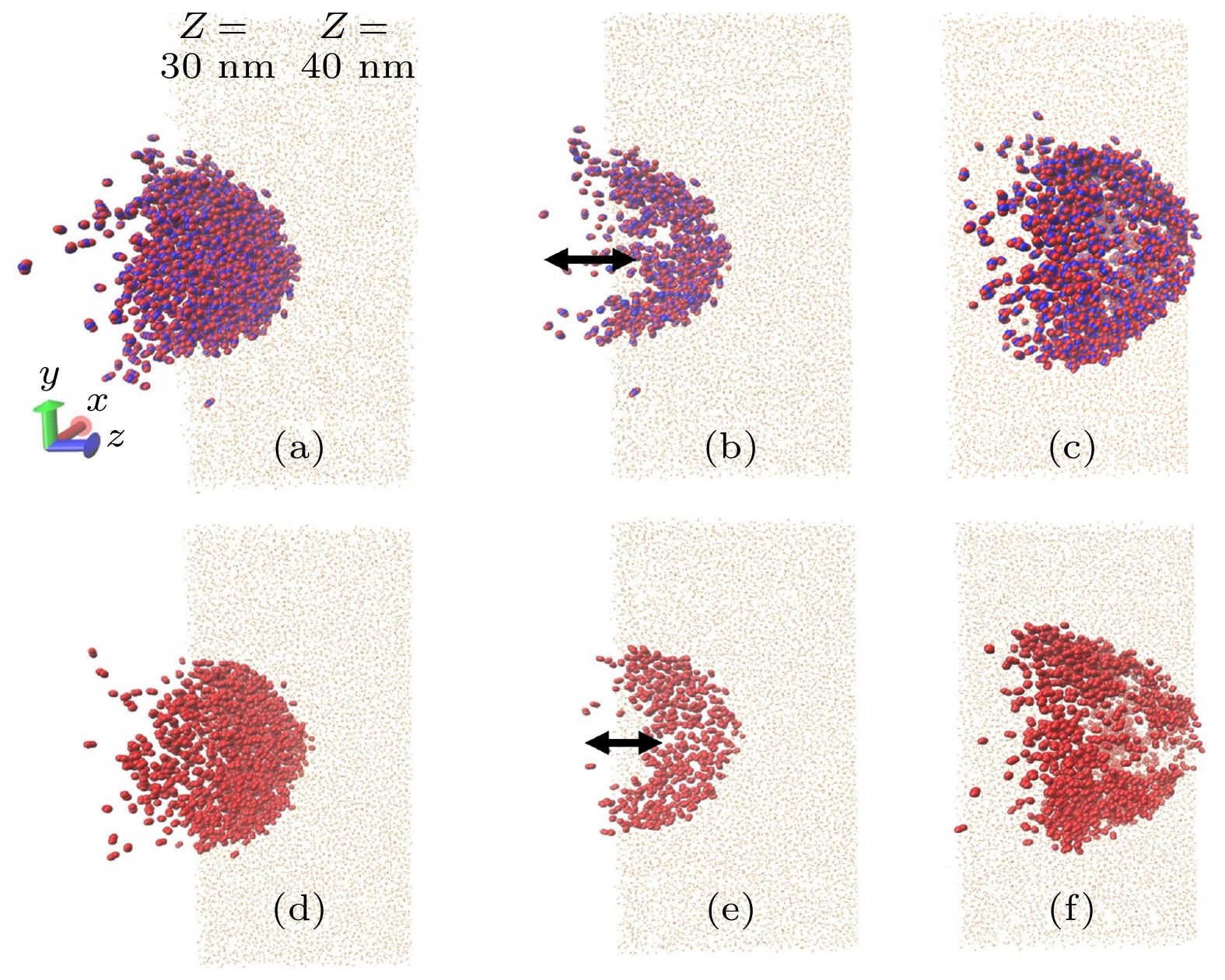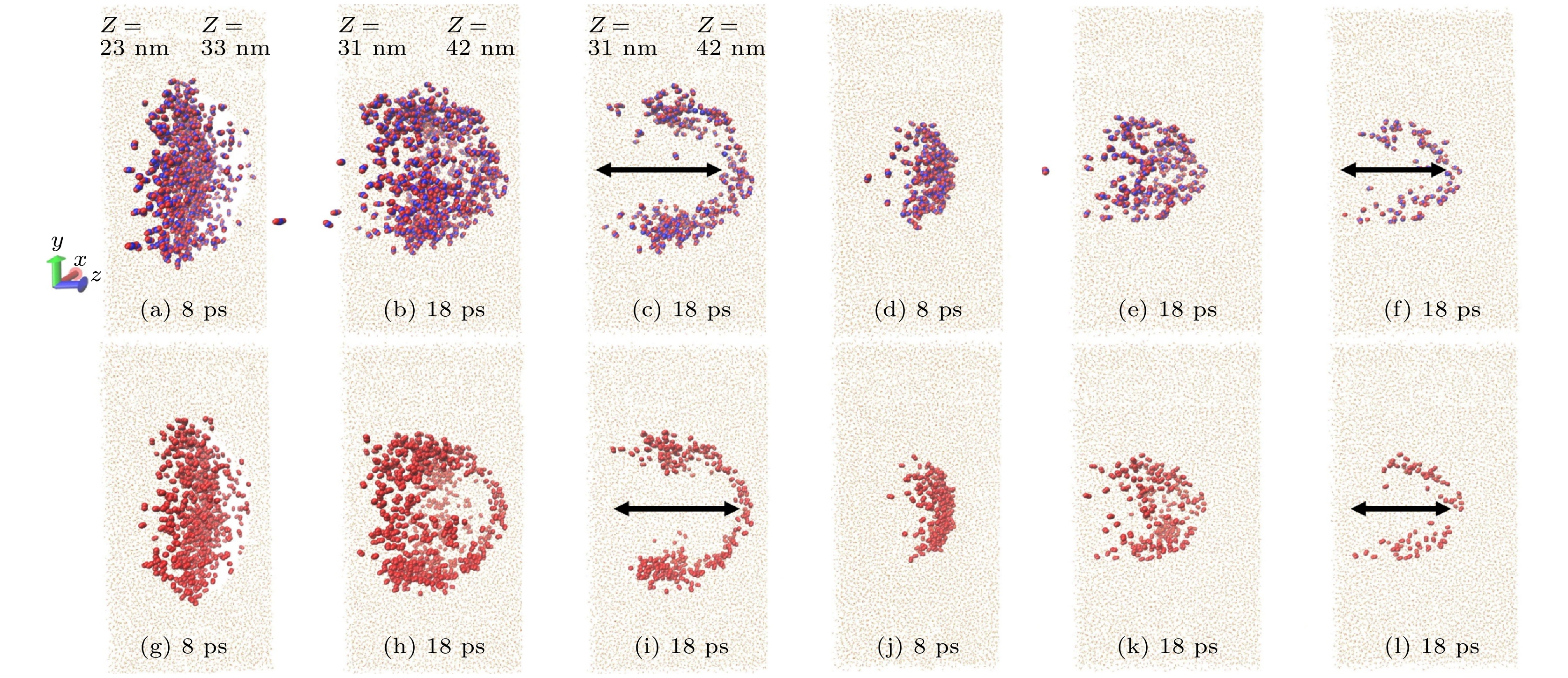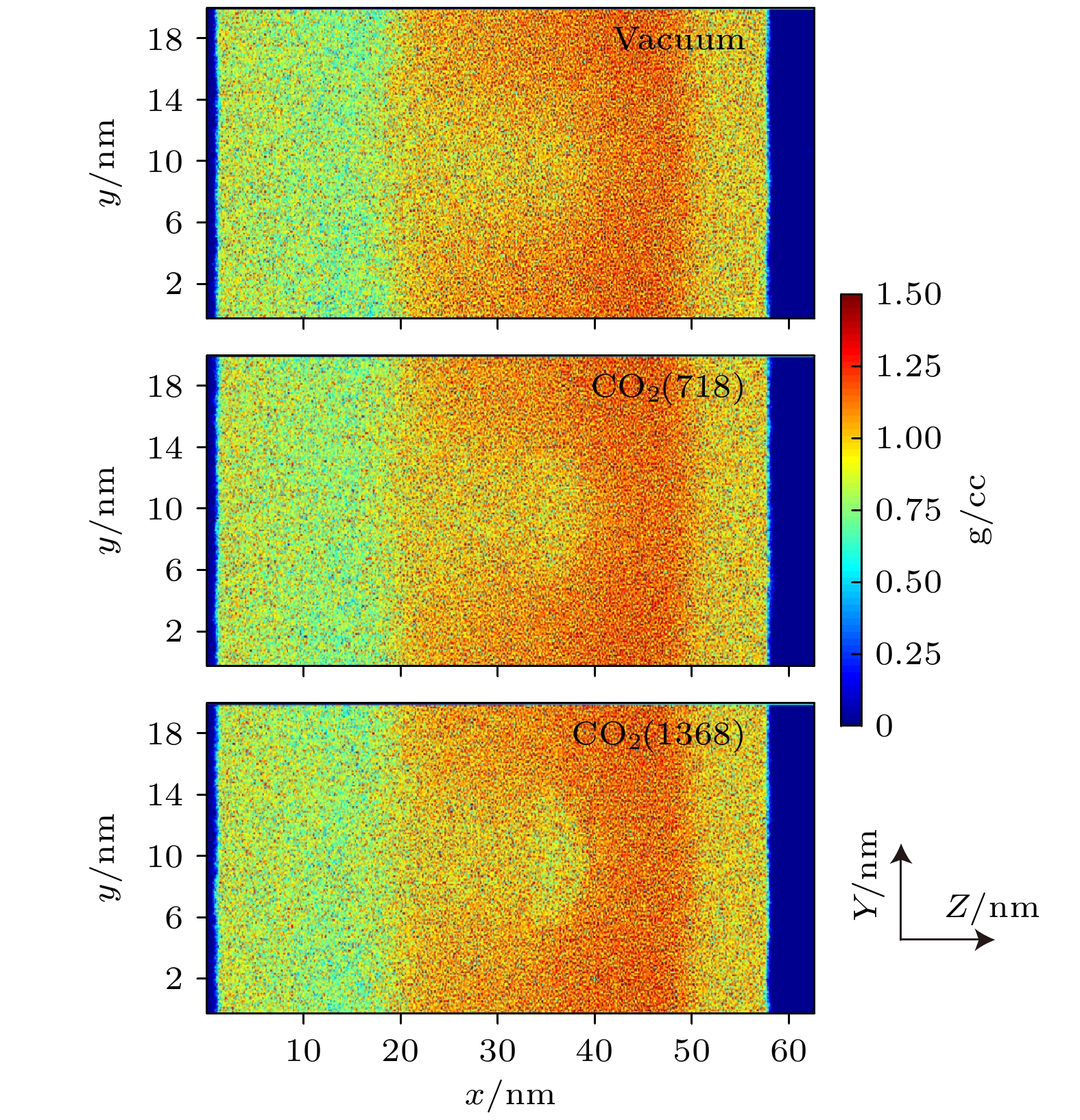-
The nanobubbles contained in the human body are induced to collapse by the shock wave, and thus produce a strong impact and high-speed nanojet, resulting in trauma to human tissues. The collapse of nanobubbles in water caused by shock waves is investigated by molecular dynamics. Nanobubbles are divided into three types: vacuum nanobubble, carbon dioxide nanobubble, and oxygen nanobubble. The influence of factors such as the number of gas molecules, the diameter of the nanobubbles, and the impulse of the shock wave on the bubble collapse are considered separately. The results show that the addition of gas molecules to vacuum nanobubbles does not affect the propagation of shock waves. However, before the nanobubbles are completely collapsed, the maximum velocity of the nanojet formed by the collapse of nanobubbles containing 718 carbon dioxide molecules (or 733 oxygen molecules) is larger than that of vacuum and nanobubbles containing 1368 carbon dioxide molecules (or 1409 oxygen molecules). After the nanobubbles are completely collapsed, the gas molecules cause the velocity of the nanojet to decay, and finally the maximum velocity of the nanojet containing gas molecules is less than that of the vacuum nanojet. In addition, it is also found that the collapse time of nanobubbles is short at high impulse, and the density and pressure when the shock wave passes at the same time are both greater. After the bubble collapses, the maximum velocity of the nanojet is larger, and the impact force is much stronger than that at a small impulse. Larger diameter nanobubble has a longer collapse time, and the density and pressure when the shock wave passes at the same time are both smaller, and the shock wave propagation is slower, but the maximum speed of the nanojet is larger. The impact is stronger. The greater the maximum velocity of the nanojet, the greater the distance that is dispersed by the gas molecules of the gas-containing nanobubbles in the impact direction will be and the deeper the depression.
-
Keywords:
- shock wave /
- nanobubble /
- collapse /
- nanojet /
- molecular dynamics
[1] Mayorga M A 1997 Toxicology 121 17
 Google Scholar
Google Scholar
[2] Scott T E, Kirkman E, Haque M, Gibb I E, Mahoney P, Hardman J G 2017 Br. J. Anaesth. 118 311
 Google Scholar
Google Scholar
[3] Hoge C W, Mcgurk D, Thomas J L, Cox A L, Engel C C, Castro C A 2008 N. Engl. J. Med. 358 453
 Google Scholar
Google Scholar
[4] Rosenfeld J V, McFarlane A C, Bragge P, Armonda R A, Grimes J B, Ling G S 2013 Lancet Neurol. 12 882
 Google Scholar
Google Scholar
[5] 李新岭, 沈岳, 赖西南, 马彦波, 刘海, 王丽丽, 陈强 2016 解放军医学杂志 41 689
 Google Scholar
Google Scholar
Li X L, Shen Y, Lai X L, Ma Y B, Liu H, Wang L L, Chen Q 2016 Med. J. Chin. People’s Liberation Army 41 689
 Google Scholar
Google Scholar
[6] 陈吉钢, 张丹枫, 王春晖, 李振兴, 董艳, 侯立军 2019 第二军医大学学报 40 763
 Google Scholar
Google Scholar
Chen J G, Zhang D F, Wang C H, Li Zh X, Dong Y, Hou L J 2019 Acad. J. Second Military Med. Univ. 40 763
 Google Scholar
Google Scholar
[7] 栗志杰, 由小川, 柳占立, 杜智博, 张仡, 杨策, 庄茁 2020 爆炸与冲击 40 100
 Google Scholar
Google Scholar
Li Z J, You X C, Liu Z L, Du Z B, ZhangY, Yang C, Zhuang Z 2020 Explosion and shock 40 100
 Google Scholar
Google Scholar
[8] Axelsson H, Yelverton J T 1996 J. Trauma Acute Care Surg. 40 S31
 Google Scholar
Google Scholar
[9] Stuhmiller J H, Ho H H, Vorst M J V, Dodd K T, Fitzpatrick T, Mayorga M 1996 J. Biomech. 29 227
 Google Scholar
Google Scholar
[10] 周杰, 陶钢, 王健 2012 爆炸与冲击 32 418
 Google Scholar
Google Scholar
Zhou J, Tao G, Wang J 2012 Explosion and shock 32 418
 Google Scholar
Google Scholar
[11] 徐成, 巨圆圆, 胡明, 龙仁荣, 阮狄克 2019 转化医学杂志 8 179
 Google Scholar
Google Scholar
Xu C, Ju Y Y, Hu M, Long R R, Ruan D K 2019 Translational Medicine Journal 8 179
 Google Scholar
Google Scholar
[12] Adhikari U, Goliaei A, Berkowitz M L 2016 Phys. Chem. Chem. Phys. 18 32638
 Google Scholar
Google Scholar
[13] Larina I V, Evers B M, Esenaliev R O 2005 Anticancer Res. 25 149
[14] Parker J L, Claesson P M, Attard P 1994 J. Phys. Chem. 98 8468
 Google Scholar
Google Scholar
[15] Ishida N, Inoue T, Miyahara M, Higashitani K 2000 Langmuir 16 6377
 Google Scholar
Google Scholar
[16] Lou S T, Ouyang Z Q, Zhang Y, Li X J, Yang F J 2000 J. Vac. Sci. Technol., B 18 2573
 Google Scholar
Google Scholar
[17] Ohgaki K, Khanh N Q, Joden Y, Tsuji A, Nakagawa T 2010 Chem. Eng. Sci. 65 1296
 Google Scholar
Google Scholar
[18] Peng H, Birkett G R, Nguyen A V 2015 Adv. Colloid Interface Sci. 222 573
 Google Scholar
Google Scholar
[19] Bunkin N F, Shkirin A V, Suyazov N V, Babenko V A, Sychev A A, Penkov N V, Belosludtsev K N, Gudkov S V 2016 J. Phys. Chem. B 120 1291
 Google Scholar
Google Scholar
[20] Pan G, He G, Zhang M, Zhou Q, Tyliszczak T, Tai R, Guo J, Bi L, Wang L, Zhang H 2016 Langmuir 32 11133
 Google Scholar
Google Scholar
[21] Ohl S W, Klaseboer E, Khoo B C 2015 Interface Focus 5 20150019
 Google Scholar
Google Scholar
[22] Ding Z, Gracewski S M 1996 J. Fluid Mech. 309 183
 Google Scholar
Google Scholar
[23] Hawker N, Ventikos Y 2012 J. Fluid Mech. 701 59
 Google Scholar
Google Scholar
[24] Vedadi M, Choubey A, Nomura K, Kalia R K, Nakano A, Vashishta P, Van Duin A C T 2010 Phys. Rev. Lett. 105 014503
 Google Scholar
Google Scholar
[25] Choubey A, Vedadi M, Nomura K, Kalia R K, Nakano A, Vashishta P 2011 Appl. Phys. Lett. 98 023701
 Google Scholar
Google Scholar
[26] Santo K P, Berkowitz M L 2014 J. Chem. Phys. 140 054906
 Google Scholar
Google Scholar
[27] Santo K P, Berkowitz M L 2015 J. Phys. Chem. B 119 8879
 Google Scholar
Google Scholar
[28] Adhikari U, Goliaei A, Berkowitz M L 2015 J. Phys. Chem. B 119 6225
 Google Scholar
Google Scholar
[29] Fu H, Comer J, Cai W, Chipot C 2015 J. Phys. Chem. Lett. 6 413
 Google Scholar
Google Scholar
[30] Lau E Y, Berkowitz M L, Schwegler E 2016 Biophys. J. 110 147
 Google Scholar
Google Scholar
[31] Goliaei A, Adhikari U, Berkowitz M L 2015 ACS Chem. Neurosci. 6 1296
 Google Scholar
Google Scholar
[32] Wu Y T, Adnan A 2017 Sci. Rep. 7 1
 Google Scholar
Google Scholar
[33] Vedadi M H, Haas S 2011 Appl. Phys. Lett. 99 154105
 Google Scholar
Google Scholar
[34] Sun D D, Lin X, Zhang Z, Gu N 2016 J. Phys. Chem. C 120 18803
 Google Scholar
Google Scholar
[35] Lu X M, Yuan B, Zhang X R, Yang K, Ma Y Q 2017 Appl. Phys. Lett. 110 023701
 Google Scholar
Google Scholar
[36] Nan N, Si D, Hu G 2018 J. Chem. Phys. 149 074902
 Google Scholar
Google Scholar
[37] Van Der Spoel D, Lindahl E, Hess B, Groenhof G, Mark A E, Berendsen H J 2005 J. Comput. Chem. 26 1701
 Google Scholar
Google Scholar
[38] Hess B, Kutzner C, van der Spoel D, Lindahl E 2008 J. Chem. Theory Comput. 4 435
 Google Scholar
Google Scholar
[39] Abraham M J, Murtola T, Schulz R, Páll S, Smith J C, Hess B, Lindahl E 2015 SoftwareX 1 19
 Google Scholar
Google Scholar
[40] Oostenbrink C, Villa A, Mark A E, Van Gunsteren W F 2004 J. Comput. Chem. 25 1656
 Google Scholar
Google Scholar
[41] Berendsen H J, Postma J P, van Gunsteren W F, Hermans J 1981 Intermolecular Forces (Dordrecht: Springer) pp331−342
[42] Berweger C D, Gunsteren W F V, Müller-Plathe F 1995 Chem. Phys. Lett. 232 429
 Google Scholar
Google Scholar
[43] Cygan R T, Romanov V N, Myshakin E M 2012 J. Phys. Chem. C 116 13079
 Google Scholar
Google Scholar
[44] Malde A K, Zuo L, Breeze M, Stroet M, Poger D, Nair P C, Oostenbrink C, Mark A E 2011 J. Chem. Theory Comput. 7 4026
 Google Scholar
Google Scholar
[45] Koziara K B, Stroet M, Malde A K, Mark A E 2014 J. Comput.-Aided Mol. Des. 28 221
 Google Scholar
Google Scholar
[46] Stroet M, Caron B, Visscher K M, Geerke D P, Malde A K, Mark A E 2018 J. Chem. Theory Comput. 14 5834
 Google Scholar
Google Scholar
[47] Lau E Y, Berkowitz M L, Schwegler E 2016 Biophysical Journal 110 147
[48] Wang X F, Tao G, Wen P, Ren B X, Pang C Q, Du C X 2020 J. Phys. Chem. B 124 9535
 Google Scholar
Google Scholar
[49] Humphrey W, Dalke A, Schulten K 1996 J. Mol. Graphics 14 33
 Google Scholar
Google Scholar
[50] Ollila O S, Risselada H J, Louhivuori M, Lindahl E, Vattulainen I, Marrink S J 2009 Phys. Rev. Lett. 102 078101
 Google Scholar
Google Scholar
[51] Vanegas J M, Torres-Sánchez A, Arroyo M 2014 J. Chem. Theory Comput. 10 691
 Google Scholar
Google Scholar
[52] Torres-Sánchez A, Vanegas J M, Arroyo M 2015 Phys. Rev. Lett. 114 258102
 Google Scholar
Google Scholar
-
图 3 u1t5 (up = 1 km/s, τs = 5 ps)条件下含二氧化碳纳米气泡(718个二氧化碳分子)完全塌陷前后的形态变化过程. 纳米气泡的直径为14 nm
Figure 3. The morphological change process of carbon dioxide-containing nanobubbles (718 carbon dioxide molecules) before and after the complete collapse under the condition of u1t5 (up = 1 km/s, τs = 5 ps). The diameter of the nanobubble is 14 nm.
图 4 u1t5 (up = 1 km/s, τs = 5 ps)条件下含二氧化碳纳米气泡(718个二氧化碳分子)完全塌陷后的内部凹陷. 纳米气泡的直径为14 nm
Figure 4. Internal depression of carbon dioxide-containing nanobubble (718 carbon dioxide molecules) after the complete collapse under the condition of u1t5 (up = 1 km/s, τs = 5 ps). The diameter of the nanobubble is 14 nm.
图 5 u1t5 (up = 1 km/s, τs = 5 ps)条件下不同时刻真空纳米气泡完全塌陷前后的一维密度分布. 纳米气泡的直径为14 nm
Figure 5. The one-dimensional density distribution before and after the complete collapse of vacuum nanobubble at different moments under the condition of u1t5 (up = 1 km/s, τs = 5 ps). The diameter of the nanobubble is 14 nm.
图 6 u1t5(up = 1 km/s, τs = 5 ps)条件下不同时刻真空与含气纳米气泡(分别含718个和1368个二氧化碳分子)完全塌陷前后的一维密度分布. 纳米气泡的直径为14 nm
Figure 6. The one-dimensional density distribution before and after the complete collapse of vacuum and gas-containing nanobubbles (containing 718 and 1368 carbon dioxide molecules, respectively) at different moments under the condition of u1t5 (up = 1 km/s, τs = 5 ps). The diameter of the nanobubble is 14 nm.
图 7 不同冲量下(u1t5和u1t3)含氧气纳米气泡(1409个氧气分子)完全塌陷前后的一维密度分布. 纳米气泡的直径为14 nm
Figure 7. The one-dimensional density distribution before and after the complete collapse of oxygen-containing nanobubbles(1409 carbon dioxide molecules) under different impulses (u1t5 and u1t3). The diameter of the nanobubble is 14 nm.
图 9 u1t5(up = 1 km/s, τs = 5 ps)条件下不同时刻含二氧化碳纳米气泡(718个二氧化碳分子)完全塌陷前后沿z轴的压力分布. 纳米气泡的直径为14 nm
Figure 9. The pressure distribution along the z-axis before and after the complete collapse of carbon dioxide-containing nanobubble (718 carbon dioxide molecules) at different moments under the condition of u1t5 (up = 1 km/s, τs = 5 ps). The diameter of the nanobubble is 14 nm.
图 10 u1t5(up = 1 km/s, τs = 5 ps)条件下不同时刻真空和含二氧化碳纳米气泡完全塌陷前后沿z轴的压力分布. 纳米气泡的直径为14 nm
Figure 10. The pressure distribution along the z-axis before and after the complete collapse of vacuum and carbon dioxide-containing nanobubbles at different moments under the condition of u1t5 (up = 1 km/s, τs = 5 ps). The diameter of the nanobubble is 14 nm.
图 11 不同冲量下(u1t5和u1t3)含氧气纳米气泡(1409个氧气分子)完全塌陷前后沿z轴的压力分布. 纳米气泡的直径为14 nm
Figure 11. The pressure distribution along the z-axis before and after the complete collapse of oxygen-containing nanobubbles (1409 carbon dioxide molecules) under different impulses (u1t5 and u1t3). The diameter of the nanobubble is 14 nm.
图 12 u1t5 (up = 1 km/s, τs = 5 ps)条件下不同直径的(14和10 nm)含二氧化碳纳米气泡完全塌陷前后沿z轴的压力分布
Figure 12. The pressure distribution along the z-axis before and after the complete collapse of dioxide-containing nanobubbles nanobubbles with different diameters (14 and 10 nm) under the condition of u1t5 (up = 1 km/s, τs = 5 ps).
图 13 u1t5 (up = 1 km/s, τs = 5 ps)条件下含氧气纳米气泡(733个氧气分子)完全塌陷前后在yz平面内的粒子速度矢量分布. 箭头方向表示速度方向, 箭头长短与颜色表示速度大小. 纳米气泡的直径为14 nm
Figure 13. The particle velocity vector distribution in the yz plane before and after the complete collapse of oxygen-containing nanobubble (733 oxygen molecules) at different moments under the condition of u1t5 (up = 1 km/s, τs = 5 ps). The direction of arrow indicates the direction of the particle velocity, and the length and color of the arrow indicate the magnitude of the particle velocity. The diameter of the nanobubble is 14 nm.
图 15 7 ps时u1t5(up = 1 km/s, τs = 5 ps)条件下含氧气纳米气泡(733个氧气分子)塌陷后在yz平面内的粒子速度矢量分布 (a)水分子和氧气分子; (b) 只有水分子; (c)只有氧气分子
Figure 15. The particle velocity vector distribution in the yz plane after the collapse of oxygen-containing nanobubble (733 oxygen molecules) at 7 ps under the condition of u1t5 (up = 1 km/s, τs = 5 ps): (a) Water molecules and oxygen molecules; (b) only water molecules; (c) only oxygen molecules.
图 16 7 ps时u1t5(up = 1 km/s, τs = 5 ps)条件下含氧气纳米气泡(1409个氧气分子)塌陷后在yz平面内的粒子速度矢量分布 (a)水分子和氧气分子; (b) 只有水分子; (c)只有氧气分子
Figure 16. The particle velocity vector distribution in the yz plane after the collapse of oxygen-containing nanobubble (1409 oxygen molecules) at 7 ps under the condition of u1t5 (up = 1 km/s, τs = 5 ps): (a) Water molecules and oxygen molecules; (b) only water molecules; (c) only oxygen molecules.
图 17 14 ps时u1t5(up = 1 km/s, τs = 5 ps)条件下真空和含氧气纳米气泡(733个氧气分子)塌陷后在yz平面内的粒子速度矢量分布 (a)含氧气纳米气泡; (b)真空纳米气泡
Figure 17. The particle velocity vector distribution in the yz plane after the collapse of vacuum and oxygen-containing nanobubbles (733 oxygen molecules) at 14 ps under the condition of u1t5 (up = 1 km/s, τs = 5 ps): (a) Oxygen-containing nanobubble; (b) vacuum nanobubble.
图 18 u1t5(up = 1 km/s, τs = 5 ps)条件下不同时刻真空和含二氧化碳纳米气泡塌陷形成的纳米射流的最大速度. 纳米气泡的直径为14 nm
Figure 18. The maximum velocity of the nanojet formed by the collapse of vacuum and carbon dioxide-containing nanobubbles at different moments under u1t5 (up = 1 km/s, τs = 5 ps). The diameter of the nanobubble is 14 nm.
图 21 u1t5(up = 1 km/s, τs = 5 ps)条件下不同直径的(14和10 nm)含气体纳米气泡塌陷形成的纳米射流的最大速度. 14 nm纳米气泡分别含718个二氧化碳分子和733个氧气分子, 10 nm纳米气泡分别含223个二氧化碳分子和232个氧气分子
Figure 21. The maximum velocity of the nanojet formed by the collapse of gas-containing nanobubbles with different diameters (14 and 10 nm) under the condition of u1t5 (up = 1 km/s, τs = 5 ps). Nanobubbles with a diameter of 14 nm contain 718 carbon dioxide molecules and 733 oxygen molecules, respectively, and nanobubbles with a diameter of 10 nm contain 223 carbon dioxide molecules and 232 oxygen molecules, respectively.
图 22 u1t5(up = 1 km/s, τs = 5 ps)条件下含不同气体分子数的纳米气泡塌陷后形态比较 (a) 718个二氧化碳分子; (b) 1368个二氧化碳分子; (c) 图(b)的截面图; (d) 733个氧气分子; (e) 1409个氧气分子; (f)图(e)的截面图. 图中水分子截取的范围为z = 30—40 nm之间. 纳米气泡的直径为14 nm
Figure 22. Under u1t5 (up = 1 km/s, τs = 5 ps), the shape comparison of nanobubbles with different numbers of gas molecules after collapse: (a) 718 carbon dioxide molecules; (b) 1368 carbon dioxide molecules; (c) the cross-sectional view of Fig. (b); (d) 733 oxygen molecules; (e) 1409 oxygen molecules; (f) the cross-sectional view of Fig. (e). The intercepted range of water molecules in the figure is between z = 30–40 nm. The diameter of the nanobubble is 14 nm.
图 23 不同冲量下纳米气泡塌陷后形态比较 (a) u1t3, 1368个二氧化碳分子; (b)图(a)的截面图; (c) u1t5, 1368个二氧化碳分子; (d) u1t3, 1409个氧气分子; (e)图(d)的截面图; (f) u1t5, 1409个氧气分子. 图中水分子截取的范围为z = 30—40 nm之间. 纳米气泡的直径为14 nm
Figure 23. The shape comparison of nanobubbles after crushing under different impulses: (a) u1t3, 1368 carbon dioxide molecules; (b) the cross-sectional view of Fig. (a); (c) u1t5, 1368 carbon dioxide molecules; (d) u1t3, 1409 oxygen molecules; (e) the cross-sectional view of Fig. (d); (f) u1t5, 1409 oxygen molecules. The intercepted range of water molecules in the figure is between z = 30–40 nm. The diameter of the nanobubble is 14 nm.
图 24 不同直径的含气纳米气泡完全塌陷前后的形态变化 (a)—(c)直径为14 nm的含718个二氧化碳分子的纳米气泡, 其中(c)是(b)的截面图; (d)—(f)直径为10 nm的含223个二氧化碳分子的纳米气泡, 其中(f)是(e)的截面图; (g)—(i)直径为14 nm的含733个氧气分子的纳米气泡, 其中(i)是(h)的截面图; (j)—(l)直径为10 nm的含232个氧气分子的纳米气泡, 其中(l)是(k)的截面图. 8 ps时水分子截取的范围为z = 23—33 nm之间, 18 ps时水分子截取的范围为z = 31—42 nm之间
Figure 24. The morphological changes of gas-containing nanobubbles with different diameters before and after they are completely collapsed: (a)–(c) nanobubble with a diameter of 14 nm containing 718 carbon dioxide molecules, where (c) is the cross-sectional view of (b); (d)–(f) nanobubble with a diameter of 10 nm containing 223 carbon dioxide molecules, where (f) is the cross-sectional view of (e); (g)–(i) nanobubble with a diameter of 14 nm containing 733 oxygen molecules, where (i) is the cross-sectional view of (h); (j)–(l) nanobubble with a diameter of 14 nm containing 232 oxygen molecules, where (l) is the cross-sectional view of (k). The intercepted range of water molecules at 8 ps is between z = 23–33 nm, and the intercepted range of water molecules at 18 ps is between z = 31–42 nm.
图 25 u1t5(up = 1 km/s, τs = 5 ps)条件下不同时刻含二氧化碳纳米气泡(1368个二氧化碳分子)完全塌陷前后的二维密度分布. 纳米气泡的直径为14 nm
Figure 25. The two-dimensional density distribution before and after the complete collapse of carbon dioxide-containing nanobubble (1368 carbon dioxide molecules) at different moments under the condition of u1t5 (up = 1 km/s, τs = 5 ps). The diameter of the nanobubble is 14 nm.
图 26 u1t5(up = 1 km/s, τs = 5 ps)条件下16 ps时真空与含二氧化碳纳米气泡完全塌陷后的二维密度分布. 纳米气泡的直径为14 nm
Figure 26. The two-dimensional density distribution before and after the complete collapse of vacuum and carbon dioxide-containing nanobubbles at 16 ps under the condition of u1t5 (up = 1 km/s, τs = 5 ps). The diameter of the nanobubble is 14 nm.
图 27 不同冲量下(u1t5和u1 t3)含氧气纳米气泡(1409个氧气分子)完全塌陷后的二维密度分布. 纳米气泡的直径为14 nm. u1t5条件下为18 ps时刻, u1t3条件下为28 ps时刻
Figure 27. The two-dimensional density distribution before and after the complete collapse of oxygen-containing nanobubbles (1409 carbon dioxide molecules) under different impulses (u1t5 and u1t3). The diameter of the nanobubble is 14 nm. It is 18 ps under condition of u1t5 and 28 ps under condition of u1t3.
图 28 u1t5(up = 1 km/s, τs = 5 ps)条件下不同直径的(14和10 nm)含氧气纳米气泡完全塌陷前后的二维密度分布. 14 nm纳米气泡含733个氧气分子, 10 nm纳米气泡含232个氧气分子
Figure 28. The two-dimensional density distribution before and after the complete collapse of oxygen-containing nanobubbles with different diameters (14 and 10 nm) under the condition of u1t5 (up = 1 km/s, τs = 5 ps). A nanobubble with a diameter of 14 nm contains 733 oxygen molecules, and a nanobubble with a diameter of 10 nm contains 232 oxygen molecules.
表 1 二氧化碳的力场参数
Table 1. Force field parameters of carbon dioxide.
qC qO εC/(kJ·mol–) εO/(kJ·mol–1) σC/Å σO/Å kCO/(kJ·mol–1·Å2) r0CO/Å kOCO/(kJ·mol–1·rad2) θ0OCO +0.6512 e –0.3256 e 0.2340 0.6683 2.800 3.028 8443 1.162 451.9 180.0° 表 2 氧气的力场参数
Table 2. Force field parameters of oxygen.
qO εO/(kJ·mol–1) σO/Å k/(kJ·mol–1·nm4) r0/Å 0.0 e 0.4997 3.400 2.2843 e+07 1.22 表 3 冲击过程模拟细节
Table 3. Simulation details of impact process.
序号 名称 纳米气泡直径/nm 粒子速度/(km·s–1) 活塞停止时间/ps 所含气体及气体分子数 1 u1t5_vacuum_10 nm 10 1.0 5 真空 2 u1t5_CO2(223)_10 nm 10 1.0 5 二氧化碳/223 3 u1t5_O2(232)_10 nm 10 1.0 5 氧气/232 4 u1t3 t_vacuum_14 nm 14 1.0 3 真空 5 u1t3_ CO2(1368)_14 nm 14 1.0 3 二氧化碳/1368 6 u1t3_ O2(1409)_14 nm 14 1.0 3 氧气/1409 7 u1t5_vacuum_14 nm 14 1.0 5 真空 8 u1t5_CO2(718)_14 nm 14 1.0 5 二氧化碳/718 9 u1t5_CO2(1368)_14 nm 14 1.0 5 二氧化碳/1368 10 u1t5_O2(733)_14 nm 14 1.0 5 氧气/733 11 u1t5_O2(1409)_14 nm 14 1.0 5 氧气/1409 -
[1] Mayorga M A 1997 Toxicology 121 17
 Google Scholar
Google Scholar
[2] Scott T E, Kirkman E, Haque M, Gibb I E, Mahoney P, Hardman J G 2017 Br. J. Anaesth. 118 311
 Google Scholar
Google Scholar
[3] Hoge C W, Mcgurk D, Thomas J L, Cox A L, Engel C C, Castro C A 2008 N. Engl. J. Med. 358 453
 Google Scholar
Google Scholar
[4] Rosenfeld J V, McFarlane A C, Bragge P, Armonda R A, Grimes J B, Ling G S 2013 Lancet Neurol. 12 882
 Google Scholar
Google Scholar
[5] 李新岭, 沈岳, 赖西南, 马彦波, 刘海, 王丽丽, 陈强 2016 解放军医学杂志 41 689
 Google Scholar
Google Scholar
Li X L, Shen Y, Lai X L, Ma Y B, Liu H, Wang L L, Chen Q 2016 Med. J. Chin. People’s Liberation Army 41 689
 Google Scholar
Google Scholar
[6] 陈吉钢, 张丹枫, 王春晖, 李振兴, 董艳, 侯立军 2019 第二军医大学学报 40 763
 Google Scholar
Google Scholar
Chen J G, Zhang D F, Wang C H, Li Zh X, Dong Y, Hou L J 2019 Acad. J. Second Military Med. Univ. 40 763
 Google Scholar
Google Scholar
[7] 栗志杰, 由小川, 柳占立, 杜智博, 张仡, 杨策, 庄茁 2020 爆炸与冲击 40 100
 Google Scholar
Google Scholar
Li Z J, You X C, Liu Z L, Du Z B, ZhangY, Yang C, Zhuang Z 2020 Explosion and shock 40 100
 Google Scholar
Google Scholar
[8] Axelsson H, Yelverton J T 1996 J. Trauma Acute Care Surg. 40 S31
 Google Scholar
Google Scholar
[9] Stuhmiller J H, Ho H H, Vorst M J V, Dodd K T, Fitzpatrick T, Mayorga M 1996 J. Biomech. 29 227
 Google Scholar
Google Scholar
[10] 周杰, 陶钢, 王健 2012 爆炸与冲击 32 418
 Google Scholar
Google Scholar
Zhou J, Tao G, Wang J 2012 Explosion and shock 32 418
 Google Scholar
Google Scholar
[11] 徐成, 巨圆圆, 胡明, 龙仁荣, 阮狄克 2019 转化医学杂志 8 179
 Google Scholar
Google Scholar
Xu C, Ju Y Y, Hu M, Long R R, Ruan D K 2019 Translational Medicine Journal 8 179
 Google Scholar
Google Scholar
[12] Adhikari U, Goliaei A, Berkowitz M L 2016 Phys. Chem. Chem. Phys. 18 32638
 Google Scholar
Google Scholar
[13] Larina I V, Evers B M, Esenaliev R O 2005 Anticancer Res. 25 149
[14] Parker J L, Claesson P M, Attard P 1994 J. Phys. Chem. 98 8468
 Google Scholar
Google Scholar
[15] Ishida N, Inoue T, Miyahara M, Higashitani K 2000 Langmuir 16 6377
 Google Scholar
Google Scholar
[16] Lou S T, Ouyang Z Q, Zhang Y, Li X J, Yang F J 2000 J. Vac. Sci. Technol., B 18 2573
 Google Scholar
Google Scholar
[17] Ohgaki K, Khanh N Q, Joden Y, Tsuji A, Nakagawa T 2010 Chem. Eng. Sci. 65 1296
 Google Scholar
Google Scholar
[18] Peng H, Birkett G R, Nguyen A V 2015 Adv. Colloid Interface Sci. 222 573
 Google Scholar
Google Scholar
[19] Bunkin N F, Shkirin A V, Suyazov N V, Babenko V A, Sychev A A, Penkov N V, Belosludtsev K N, Gudkov S V 2016 J. Phys. Chem. B 120 1291
 Google Scholar
Google Scholar
[20] Pan G, He G, Zhang M, Zhou Q, Tyliszczak T, Tai R, Guo J, Bi L, Wang L, Zhang H 2016 Langmuir 32 11133
 Google Scholar
Google Scholar
[21] Ohl S W, Klaseboer E, Khoo B C 2015 Interface Focus 5 20150019
 Google Scholar
Google Scholar
[22] Ding Z, Gracewski S M 1996 J. Fluid Mech. 309 183
 Google Scholar
Google Scholar
[23] Hawker N, Ventikos Y 2012 J. Fluid Mech. 701 59
 Google Scholar
Google Scholar
[24] Vedadi M, Choubey A, Nomura K, Kalia R K, Nakano A, Vashishta P, Van Duin A C T 2010 Phys. Rev. Lett. 105 014503
 Google Scholar
Google Scholar
[25] Choubey A, Vedadi M, Nomura K, Kalia R K, Nakano A, Vashishta P 2011 Appl. Phys. Lett. 98 023701
 Google Scholar
Google Scholar
[26] Santo K P, Berkowitz M L 2014 J. Chem. Phys. 140 054906
 Google Scholar
Google Scholar
[27] Santo K P, Berkowitz M L 2015 J. Phys. Chem. B 119 8879
 Google Scholar
Google Scholar
[28] Adhikari U, Goliaei A, Berkowitz M L 2015 J. Phys. Chem. B 119 6225
 Google Scholar
Google Scholar
[29] Fu H, Comer J, Cai W, Chipot C 2015 J. Phys. Chem. Lett. 6 413
 Google Scholar
Google Scholar
[30] Lau E Y, Berkowitz M L, Schwegler E 2016 Biophys. J. 110 147
 Google Scholar
Google Scholar
[31] Goliaei A, Adhikari U, Berkowitz M L 2015 ACS Chem. Neurosci. 6 1296
 Google Scholar
Google Scholar
[32] Wu Y T, Adnan A 2017 Sci. Rep. 7 1
 Google Scholar
Google Scholar
[33] Vedadi M H, Haas S 2011 Appl. Phys. Lett. 99 154105
 Google Scholar
Google Scholar
[34] Sun D D, Lin X, Zhang Z, Gu N 2016 J. Phys. Chem. C 120 18803
 Google Scholar
Google Scholar
[35] Lu X M, Yuan B, Zhang X R, Yang K, Ma Y Q 2017 Appl. Phys. Lett. 110 023701
 Google Scholar
Google Scholar
[36] Nan N, Si D, Hu G 2018 J. Chem. Phys. 149 074902
 Google Scholar
Google Scholar
[37] Van Der Spoel D, Lindahl E, Hess B, Groenhof G, Mark A E, Berendsen H J 2005 J. Comput. Chem. 26 1701
 Google Scholar
Google Scholar
[38] Hess B, Kutzner C, van der Spoel D, Lindahl E 2008 J. Chem. Theory Comput. 4 435
 Google Scholar
Google Scholar
[39] Abraham M J, Murtola T, Schulz R, Páll S, Smith J C, Hess B, Lindahl E 2015 SoftwareX 1 19
 Google Scholar
Google Scholar
[40] Oostenbrink C, Villa A, Mark A E, Van Gunsteren W F 2004 J. Comput. Chem. 25 1656
 Google Scholar
Google Scholar
[41] Berendsen H J, Postma J P, van Gunsteren W F, Hermans J 1981 Intermolecular Forces (Dordrecht: Springer) pp331−342
[42] Berweger C D, Gunsteren W F V, Müller-Plathe F 1995 Chem. Phys. Lett. 232 429
 Google Scholar
Google Scholar
[43] Cygan R T, Romanov V N, Myshakin E M 2012 J. Phys. Chem. C 116 13079
 Google Scholar
Google Scholar
[44] Malde A K, Zuo L, Breeze M, Stroet M, Poger D, Nair P C, Oostenbrink C, Mark A E 2011 J. Chem. Theory Comput. 7 4026
 Google Scholar
Google Scholar
[45] Koziara K B, Stroet M, Malde A K, Mark A E 2014 J. Comput.-Aided Mol. Des. 28 221
 Google Scholar
Google Scholar
[46] Stroet M, Caron B, Visscher K M, Geerke D P, Malde A K, Mark A E 2018 J. Chem. Theory Comput. 14 5834
 Google Scholar
Google Scholar
[47] Lau E Y, Berkowitz M L, Schwegler E 2016 Biophysical Journal 110 147
[48] Wang X F, Tao G, Wen P, Ren B X, Pang C Q, Du C X 2020 J. Phys. Chem. B 124 9535
 Google Scholar
Google Scholar
[49] Humphrey W, Dalke A, Schulten K 1996 J. Mol. Graphics 14 33
 Google Scholar
Google Scholar
[50] Ollila O S, Risselada H J, Louhivuori M, Lindahl E, Vattulainen I, Marrink S J 2009 Phys. Rev. Lett. 102 078101
 Google Scholar
Google Scholar
[51] Vanegas J M, Torres-Sánchez A, Arroyo M 2014 J. Chem. Theory Comput. 10 691
 Google Scholar
Google Scholar
[52] Torres-Sánchez A, Vanegas J M, Arroyo M 2015 Phys. Rev. Lett. 114 258102
 Google Scholar
Google Scholar
Catalog
Metrics
- Abstract views: 9593
- PDF Downloads: 181
- Cited By: 0















 DownLoad:
DownLoad:

